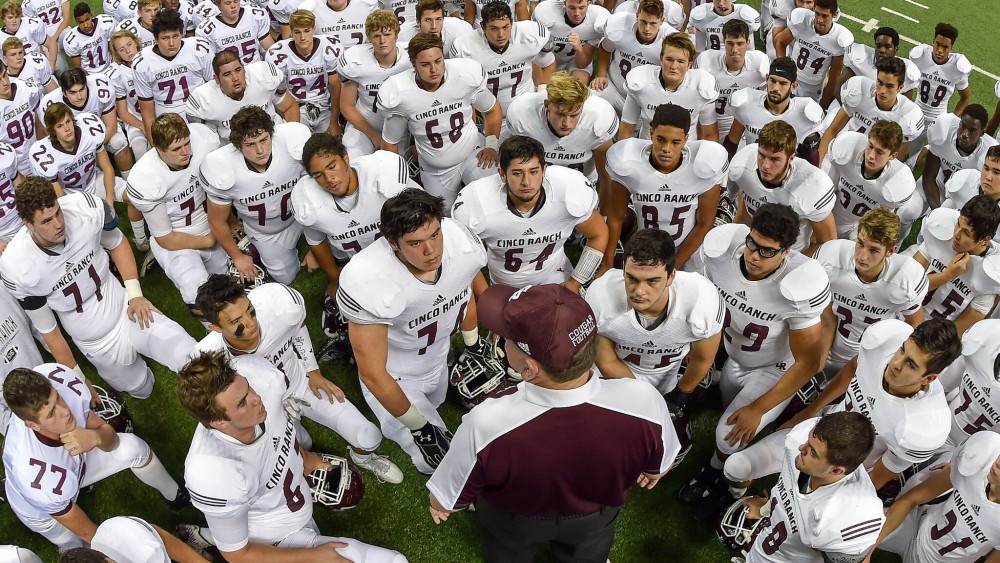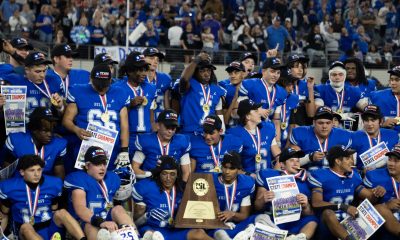
Of all the famous bloodsports, there is none that’s more famous in the current day than Roman gladiatorial combat. You’ve likely seen the basics on the silver screen – two people (slaves) met up in mano a mano, helmets adorned with plumes, the more famous gladiators with their personal armor and weapons, Russell Crowe half murmuring inspirational lines. That isn’t a joke either, arguably one of the most insightful lines I’ve ever heard on film comes not even five minutes into Gladiator, the epic built around a tale of betrayal and vengeance in the last days of Rome.
QUINTUS: “People should know when they’re conquered.”
MAXIMUS: “Would you, Quintus? Would I?”
Gladiator was a smash hit, it lit a flame in many, as evidenced by the many Academy Awards it netted, specifically for Best Picture and Best Actor, that went to Crowe as Maximus Decimus Mereidius, General of the Felix Legions, Loyal to the True Emperor, Marcus Aurelius, Father to a murdered son, Husband to a murdered wife, the one who had his vengeance, in both that life and the next. The movie single handedly spawned at least tens of thousands of men’s small group discussions across the country, discussions about the nature of manhood and honor, discussions about the duality of vengeance and justice.
All of these things are great, and fine, but the real kicker is that the story in Gladiator never actually happened, and the actual tales of gladiators prove the validity of the phrase, “truth is stranger than fiction”, widely attributed to Lord Byron, an Anglo-Scottish poet.
Why not focus on the real, on the truth when making these types of things? There’s the story of Spartacus, the Thracian who was enslaved for deserting the Romans, who eventually lead an uprising against his masters. There’s the story of Carpophorus, the greatest bestiarii of his time, who the poet Martial claims killed 20 wild beasts in a single battle. There’s the entire history of the Naiunachiarii, those would fight in the sea battles that were made possible by the Romans literally filling the Coliseum with water, throwing some ships in it, and having two sides square off in naval epics. Of course, there’s some Hollywood thrown in Gladiator, as it’s more interesting to watch solo combat and mass confusion in battle scenes than it is to watch Roman soldiers remain in formation. It’s more impressive to hear Maximus say “general of the Felix Legions” than it is to hear “Felix Legion”, due to the fact that there was only one Felix Legion. You have all of these great stories in front of you, why focus on the ones that aren’t true, or are only possibilities?
**
Like some of you, I watched the season opening showdown between Cedar Hill and Bishop Gorman, a game that we’re so far removed from at this point that it might as well have been played in 2015. Despite the pride and tradition of Texas High School Football, Cedar Hill was a decided underdog to Tate Martell, Biaggio Ali-Walsh, Haskill Garrett, and the rest of the Gaels’ star-studded squad. This isn’t meant to say that Cedar Hill was without talent, Avery Davis, Charleston Rambo, Dimitri Moore, and the rest of the Longhorns had plenty of firepower to go step-for-step with the Gaels in many areas.
The game itself was a slog for many Texans, as a suffocating defensive line and tough running from Martell and Ali-Walsh punished the Longhorns at the line of scrimmage. White jerseys seemingly filled every gap, forcing the Longhorns to score in unconventional ways, roll their coverages, and stack the box, which eventually lead to Martell simply chucking the ball over the top for big gains.
In a clash between the best the nation had to offer and Texas, Texas fell short by 30 points. Later, as Cedar Hill’s season wore on, we’d find out that the Longhorns weren’t the best in Texas, although they were very good, a point that many tried to argue the second that Cedar Hill fell behind, as Texans are very proud of their High School football, and for good reason.
As the game wore on however, the main source of frustration from Texans seemed to come from how the announcers were treating the game. “It’s all about recruits and not what’s happening on the field!”, exasperated fans would cry as chyrons trumpeting the schools that had offered the players on the field appeared on HD LED screens across the state. “Talk about the game!”, shouted those who honestly could not give a rat’s ass about what school had offered who and what recruiting class was transcendent.
This critique is not without merit, in fact it might be the biggest indictment of how top ranked high schoolers are treated. We have at least a zillion different websites dedicated to tracking recruits’ progress, we have dedicated recruiting analysts that put food on their table and a roof over their heads through the process of identifying which players will be better at the next level of football. It’s a process that is completely foreign to me, and frankly, beyond my understanding of football strategy as it comes to the Jimmys and the Joes. There are much smarter people than me out there, those that can say with certainty which cornerback has more fluid hips, or break down the minutia of the throwing motion of various quarterbacks.
It’s an important critique, why show games at all if all we’re going to do is discuss recruits? Why not just televise recruiting camps like we televise the combine? Why is the future more important than what’s happening now? Why do we talk more about big name recruits who don’t show up in the box score than those who are all over the field, yet are 5’6 and have no offers?
Why is the focus on the individual, and not on the team?
***
I haven’t seen the remake of Ben-Hur, and you couldn’t pay me a sum of money large enough for me to sit through that catastrophe. Jack Huston is no Charlton Heston, it’s pretty much impossible to remake something as excellent as the original and have it live up to the hype. In this case, not only did it not live up to the original, it didn’t live up to the standard of a good movie. It was bad, awful, terrible, disgusting, pick your negative adjective, and it will probably describe it to some extent. You can’t really live up to something as classic as the original Ben-Hur, so many scenes were botched, including an all-time favorite for many, the chariot racing scene.
Football players are often described as gladiators, and on several levels this is a comparison that makes sense. There’s the young man, arms outstretched, welcoming the cheers from the crowd. As a young man, one of the first things my father told me about football, and the only accurate description of the sport I’ve heard to date, came when he sat me down after one of the first practices I ever had and said, “Dancing, if done well, is a contact sport. Football is a collision sport.”
Although the violence inherent to football is nowhere near on par with the violence of the gladiatorial games, violence is still integral to both. Football is as much about technical perfection as it is about simply beating the hell out of the guy across from you, creating an environment where this game, a game played with a pigskin wrapped around air, is no longer a fun game. We don’t outright kill people in football, we simply make it so unbearably painful for the opposition to the point where they want to quit.
It’s easy to connect the violence of football and the violence of the life of a gladiator, but every comparison we make never really rings true. Football is inherently about violence, and the crowd is a factor, but except in certain circumstances, the gladiatorial games aren’t fully about team. A more apt comparison, if we can stay in Roman history, would be chariot racing.
Despite the popularity of gladiators, chariot racing might be the oldest and definitely the most popular sport for the Romans. It dates back to the time of the Greeks, and was held alongside the gladiatorial matchups as an equal sport, if not a more popular one back then. It’s not exactly hard to figure out chariot racing, it’s like NASCAR, but with horses, in oval-shaped stadiums called Circuses. The agiatores, or charioteers, began their careers mostly as slaves, and some raced so well that they bought their freedom, not unlike the gladiators.
The ways that chariot racing differs from gladiatorial combat are small, where some would become fond of a single gladiator, most chariot racing fans would devote themselves to the various factions and their colors. It wasn’t really that unlike being a fan today, you have your favorite team, you wear their colors, and you support them come hell or high water. Pliny the Younger criticized this in his writings, saying this from Letters 9.6:
“I am the more astonished that so many thousands of grown men should be possessed again and again with a childish passion to look at galloping horses, and men standing upright in their chariots. If, indeed, they were attracted by the swiftness of the horses or the skill of the men, one could account for this enthusiasm. But in fact it is a bit of cloth they favour, a bit of cloth that captivates them.”
While the drivers raced around an oval, like NASCAR, the similarities largely end there. Drivers were not just allowed to ram other chariots, they were encouraged to, and since racing chariots weren’t armored, the drivers were severely at risk. The main reason I believe that that chariot racing is closer to football than the gladiator games were is the team aspect, though.
****
There are some Texas High School football fans that prefer the smaller school games to the larger ones. For all of the talent, all of the glass palaces built to honor football that they play in, all of the national fanfare, there’s a legitimate argument to be made that the smaller schools play a purer brand of football.
It’s a brand that’s built around one thing and one thing only: Team Above All. In order to win games with kids that often aren’t the biggest, the fastest, or the strongest, smaller schools have to rely more on the unification into one body to win games. These kids grew up around each other, not just going to school, but doing life together, in a way that only young men isolated in a single town do life together. This isn’t to diminish the bond that bigger schools have, but to point out that there’s something about the small towns that’s different.
They don’t generally play fast and loose, they play together, like a well oiled machine. They have to if they want to win. Stars are amplified in these small towns, the use of exceptional players becomes a much bigger deal when you don’t have the depth to truly deal with a player getting hurt.
There are some fans that prefer the bigger games. They love the flashy, 40-yards-in-the-air bombs that feature a kid headed to TCU throwing to a kid headed to Oklahoma. There’s talent, speed, some of the names you’ll hear on those Friday nights you’ll hear on Sunday nights in less than a decade. It’s the same game but a different style, teams can have multiple stars, recruits are all over the field, and from a talent standpoint, it’s a higher level of competition. You’re the best, and you have to beat the best to win games.
The concept of “Team” is something that some would argue that we’ve lost in the midst of college recruitment, heightened by the massive budgets of colleges and the lucrative contracts of the NFL. Some say that it’s something that only exists at the smaller classifications these days, brought on partially by necessity and partially by the industry that’s been created around recruiting.
I personally can’t believe that, at least not completely. While there is extreme athleticism and talent involved in the 40-yard bomb, there’s also a line that has to block for that pass to happen, presnap reads that have to be executed, and audibles that have to be called. There’s an extreme level of “Team” that goes into those. Any that argue that a top running back recruit in a shiny chrome helmet and a brand-new team color jersey juking the socks out of a top defensive back recruit in a different color shiny chrome helmet and a brand new white jersey isn’t about team discount the offensive line that got that running back into the open field. Any that argue that a linebacker shooting the A gap, getting a tackle in the backfield, celebrating with a signature dance, then celebrating with his teammates isn’t about team misses the defensive line who took up the blocks necessary for him to make that play, and might be just as excited as he is.
By the same token, any that argue that the smaller schools without talent play better football, discredit the talent that it takes to play the game of football at a high level. It takes a certain level of talent to be able to execute plays well, lots of fast-twitch muscles and a lot of thinking on the fly. These small schools are athletic, they are talented, it’s just a different form of talent.
In order to succeed in football, you need a combination of talent and team. It’s the reason why Katy has been such a dominant program for so long, if football teams can be compared to weapons, then Katy is a scalpel. It’s a precise weapon, one forged out of skill and unification. There’s a reason why Bremond is so good too, Roshauud Paul is a phenomenal athlete, and Bremond plays as unified as any top team in the state.
*****
It’s been 107 days since that Cedar Hill – Bishop Gorman game, 107 days since we looked at a broadcast and pondered on its meaning, what it signified of the present, and the precedent that it set for the future. Through all the bluster of recruiting, and all that this seems to mean nearly every single time it happens, High School football still remains in Texas. It hasn’t gone anywhere, and it’s not leaving anytime soon.
It’s easy to take a surface level look at the state of football and say that it isn’t as good as it was. In many ways, that can be true, but only on the level of individual teams. Football is still here, and at the high school level in Texas, it remains pure.
I say all of this to say that the concept of “Team” is not dead, despite all evidence to the contrary, and nothing can make me disbelieve that. There’s a duality here, “Team” can exist even through all the pomp and circumstance, all the talk of recruiting, and yes, all the various chrome helmets. It merely comes through different avenues these days. Yes, there are teams that don’t play unified. Yes, there are those who are rugged individualists. However, I firmly believe that they are few and far between, and that the spirit of Texas High School football – which largely rests around the concept of “Team” – is still alive.
Brought to you by:


















